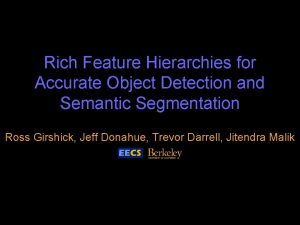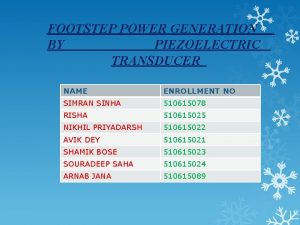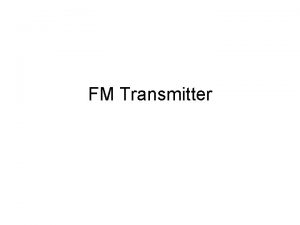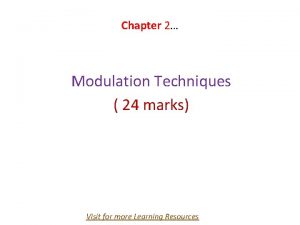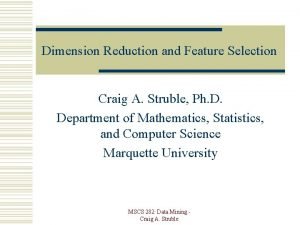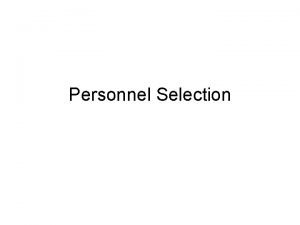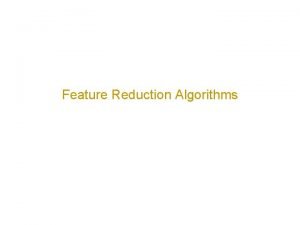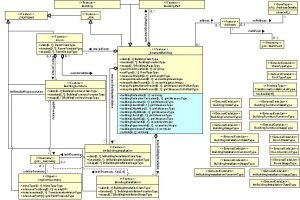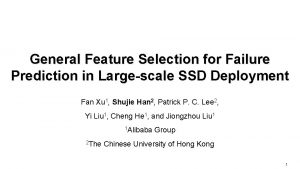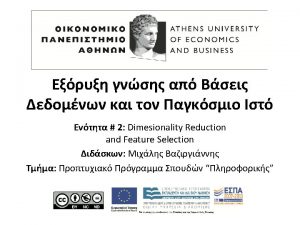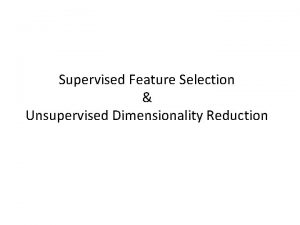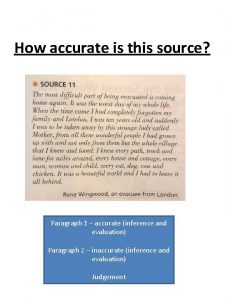Using Feature Generation Feature Selection for Accurate Prediction
















![Technique Comparisons § Pedersen&Nielsen [ISMB’ 97] § Our approach l l Neural network No Technique Comparisons § Pedersen&Nielsen [ISMB’ 97] § Our approach l l Neural network No](https://slidetodoc.com/presentation_image/31ce934694246ecfb13d86ba8a9b002c/image-17.jpg)

- Slides: 18

Using Feature Generation & Feature Selection for Accurate Prediction of Translation Initiation Sites Fanfan Zeng & Roland Yap National University of Singapore Limsoon Wong Institute for Infocomm Research

Translation Initiation Recognition

A Sample c. DNA 299 HSU 27655. 1 CAT U 27655 Homo sapiens CGTGTGTGCAGCAGCCTGCAGCTGCCCCAAGCCATGGCTGAACACTGACTCCCAGCTGTG CCCAGGGCTTCAAAGACTTCTCAGCTTCGAGCATGGCTTTTGGCTGTCAGGGCAGCTGTA GGAGGCAGATGAGAAGAGGGAGATGGCCTTGGAGGAAGGGGCCTGGTGCCGAGGA CCTCTCCTGGCCAGGAGCTTCCTCCAGGACAAGACCTTCCACCCAACAAGGACTCCCCT. . . . . . i. EEEEEEEEEEEEEEEEEEEEEEEEEEEEEEEEEEEEEEEEEEEE What makes the second ATG the translation initiation site? 80 160 240

Our Approach § Training data gathering § Signal generation § k-grams, distance, domain know-how, . . . § Signal selection § Entropy, 2, CFS, t-test, domain know-how. . . § Signal integration § SVM, ANN, PCL, CART, C 4. 5, k. NN, . . .

Training & Testing Data § § § Vertebrate dataset of Pedersen & Nielsen [ISMB’ 97] 3312 sequences 13503 ATG sites 3312 (24. 5%) are TIS 10191 (75. 5%) are non-TIS Use for 3 -fold x-validation expts

Signal Generation § K-grams (ie. , k consecutive letters) l l K = 1, 2, 3, 4, 5, … Window size vs. fixed position Up-stream, downstream vs. any where in window In-frame vs. any frame

Too Many Signals § For each value of k, there are 4 k * 3 * 2 k-grams § If we use k = 1, 2, 3, 4, 5, we have 4 + 24 + 96 + 384 + 1536 + 6144 = 8188 features! § This is too many for most machine learning algorithms

Signal Selection (Basic Idea) § Choose a signal w/ low intra-class distance § Choose a signal w/ high inter-class distance § Which of the following 3 signals is good?

Signal Selection (eg. , t-statistics)

Signal Selection (eg. , CFS) § Instead of scoring individual signals, how about scoring a group of signals as a whole? § CFS l A good group contains signals that are highly correlated with the class, and yet uncorrelated with each other

Sample k-grams Selected by CFS Kozak consensus Leaky scanning § Position – 3 § in-frame upstream ATG § in-frame downstream l l Stop codon TAA, TAG, TGA, CTG, GAC, GAG, and GCC Codon bias?

Signal Integration § k. NN Given a test sample, find the k training samples that are most similar to it. Let the majority class win. § SVM Given a group of training samples from two classes, determine a separating plane that maximises the margin of error. § Naïve Bayes, ANN, C 4. 5, . . .

Results (3 -fold x-validation)

Improvement by Voting § Apply any 3 of Naïve Bayes, SVM, Neural Network, & Decision Tree. Decide by majority.

Improvement by Scanning § Apply Naïve Bayes or SVM left-to-right until first ATG predicted as positive. That’s the TIS. § Naïve Bayes & SVM models were trained using TIS vs. Up-stream ATG

Performance Comparisons * result not directly comparable
![Technique Comparisons PedersenNielsen ISMB 97 Our approach l l Neural network No Technique Comparisons § Pedersen&Nielsen [ISMB’ 97] § Our approach l l Neural network No](https://slidetodoc.com/presentation_image/31ce934694246ecfb13d86ba8a9b002c/image-17.jpg)
Technique Comparisons § Pedersen&Nielsen [ISMB’ 97] § Our approach l l Neural network No explicit features § Zien [Bioinformatics’ 00] l SVM+kernel engineering l No explicit features § Hatzigeorgiou [Bioinformatics’ 02] l l l Multiple neural networks Scanning rule No explicit features l Explicit feature generation l Explicit feature selection l l Use any machine learning method w/o any form of complicated tuning Scanning rule is optional

Acknowledgements § A. G. Pedersen § H. Nielsen
 Rich feature hierarchies
Rich feature hierarchies Stahl
Stahl Lord you are good and your mercy is forever
Lord you are good and your mercy is forever Balancing selection vs stabilizing selection
Balancing selection vs stabilizing selection Artificial selection vs natural selection
Artificial selection vs natural selection K selection r selection
K selection r selection Natural selection vs artificial selection
Natural selection vs artificial selection Artificial selection vs natural selection
Artificial selection vs natural selection Example of stabilizing selection
Example of stabilizing selection K selection r selection
K selection r selection Natural selection vs artificial selection
Natural selection vs artificial selection Two way selection and multiway selection
Two way selection and multiway selection Multiway selection
Multiway selection Procedure of pure line selection
Procedure of pure line selection Footstep power generation using piezoelectric sensor
Footstep power generation using piezoelectric sensor Vco fm modulator
Vco fm modulator What is the difference between am and fm waves
What is the difference between am and fm waves Information gain feature selection
Information gain feature selection Information gain feature selection
Information gain feature selection
